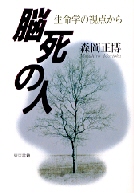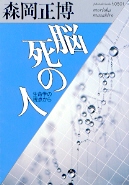Book
|
English Edition
(Some chapters have been translated) |


|
Brain-Dead Person
: Human relationship–oriented Analysis of Brain Death (1989)
Masahiro Morioka |
A very influential text in Japanese bioethics. This is a book that helped shift the Japanese discussion on brain death from "brain-centered analysis" to "human relationship oriented analysis." Brain death is redefined in terms of the human relationships between a comatose patient and the people surrounding him/her.
Special attention is paid to the emotions of the family members of a brain dead person, because sometimes the family members at the bedside, touching the warm body of the patient, express a sense that the brain dead person still continues to exist as a living human being. This approach, published more than 20 years ago, has deeply influenced Japanese bioethics.
In Chapter 5 the author discusses the difference between the "death of oneself" and the "death of the other," and explores its implications for our views of life and death. In Chapters 6 and 7, he discusses the future of modern medicine and advanced scientific civilizations. The key concept of irreplaceability is introduced in the last chapter. See also "Reconsidering Brain Death," Hastings Center Report, 2001.
Chapter 1
Brain Death as a Form of Human Relationship
-
What Doctors May not Know
- What does Brain Death Mean to a Family?
- The "Person" Whose Brain Has Stopped Functioning
- The Condition of a "Brain Dead Person"
- Is "Personhood" Limited to Those Who are "Alive?"
- The Relationship Between a Brain Dead Person and the People Around Him or Her
Chapter 2
What Kind of Place is an Intensive Care Unit?
- Intensive Monitoring and Visiting Limitations in the ICU
- The Integration of Compartmentalized Medical Treatment
- The System of Supervision and Efficient Treatment
- The Problem of a Brain Dead Person Occupying a Bed
- Funding Treatment and Providing Iinsurance for Brain Dead People
- What is the Best Way to Treat and Nurse a Brain Dead Person?
- Medical Treatment that Centers around Care of the Sphere of Person to Person Relationships
- Caring for Brain Dead People
- Moving the Bed outside the ICU
- From Life Saving Medicine to Medicine Centered around Nursing
- Implementing Attendance as a Form of Medical Treatment
Chapter 3
The Light and Shadow of Organ Transplantation
Chapter 4
Various Uses of a Brain Dead Body
Chapter 5
My Death and the Death of Others
- The Death of a Person is not Limited to Only the Medical and Legal Aspects
- My Death, the Death of a Person Familiar to Me, and the Death of a Person Unfamiliar to Me
- The Meaning of Death to a Person Directly Concerned with that Death
Chapter 6
Compartmentalization of Modern Medicine
Chapter 7
Efficiency and Irreplaceability
- “Medical Treatment as Repair”
- The Pursuit of Efficiency
- The Ideology of a Society That Distributes Goods
- Respecting Irreplaceability
- The Antinomy of “Efficiency” and “Irreplaceability”
- The Logic of “Onlookers” and the Logic of Those Directly Involved
Book Reviews
Robert D. Truog, MD, Harvard University - "I think your way of presenting these three categories and explaining the differences between them in terms of the relationships between people is a wonderful and very useful insight....." (Commentary on "Brain Dead Person" Chapter 1 [Nov.24,2001] ) >> Read more
Publication Data
Tokyo Shoseki, Tokyo, Mar.,1989, Out of Print
--- Fukutake Shoten, Tokyo, Jun.,1991, Out of Print
--- Hozokan, Tokyo, Jul.,2000, 271pages, 2400yen.
Written in Japanese
Japanese website for this book
You can read the entire Japanese text.

Tokyo Shoseki edition (1989) |

Fukutake Bunko edition (1991) |

Hozokan edition (2000) |
|
